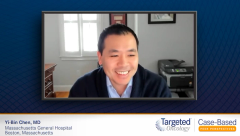
Clinical Risk Factors and Prophylaxis for aGvHD
Yi-Bin Chen, MD, defines acute graft-versus-host disease (aGvHD) as a complication of allogeneic transplant, discusses the clinical risk factors, and reviews prophylactic treatment options.
Yi-Bin Chen, MD: Acute graft-versus-host disease [aGvHD] is a complication of allogeneic transplantation in the mechanism of action. For most patients, we transplant. The potential curative modality here is an immunological attack of the donor graft upon the patient’s underlying malignancy, this graft vs malignancy effect.
The corollary to that is graft-versus-host disease. Graft-versus-host disease is a donor’s immune system attacking the host’s healthy body. You can view that as organ rejection from within because we’re transplanting the host with a new immune system. It is a potential complication of all allogeneic transplants, and every allogeneic transplant recipient will receive some form of graft-versus-host disease prevention.
There are several well-defined clinical risk factors for acute graft-versus-host disease. We know things like older age of the donor and recipient predisposal are associated with increased risk of aGvHD. We know the degree of HLA [human leukocyte antigen] mismatch, so if the recipient and donor have a higher degree of incompatibility, that intuitively leads to a higher incidence of acute graft-versus-host disease. The intensity of the conditioning regimen used before transplant is associated with a higher incidence of aGvHD, specifically the use of higher doses of total body range.
An interesting risk factor that has emerged over the last decade is the health of the microbiome of the recipient, meaning the diversity of the bacteria in the stool or the colon of the patient. Patients who have a restrictive diversity, which we call dysbiosis, seem to be at a much higher risk of developing acute graft-versus-host disease than those who have a diverse microbiome.
It’s tough to know if the microbiome is just a marker of certain things or if there’s a cause-and-effect relationship. Exciting research is ongoing to see if it can be manipulated.
There are different regimens used for graft-versus-host disease prophylaxis, and those can shape the risk and incidence after transplant. Traditionally, the more immunosuppression you have around a transplant to prevent graft-versus-host disease, the more it would result in a higher incidence of infection or even relapse of malignancy out back. Outcomes are fairly similar, but more modern regimens may be changing this. We hope to see results of clinical trials going forward that help improve outcomes for patients, ultimately sparing them graft-versus-host disease.
Acute graft-versus-host disease is common; it probably affects about 30% to 35% of patients after conventional transplant. When I talk about aGvHD, I’m talking about grades 2 to 4, which usually require the initiation of systemic treatment and have been shown to correlate with outcomes, as well as have an effect on patient outcomes in the long run.
Every recipient does receive some form of prevention. There are 2 real categories of graft-versus-host disease prevention. One is ex vivo manipulation of the graft. That means our cytotherapy lab gets the cells from the donor and manipulates them. This has traditionally been called T-cell depletion, so you can either take a graft and select for the stem cells or select the T cells of that donor graft to try to prevent graft-versus-host disease.
The much more common way we prevent graft-versus-host disease is through medications. Traditionally, we use a combination of a calcineurin inhibitor, such as tacrolimus or cyclosporine, added to short doses of methotrexate out back. There have been variations on this platform of a calcineurin inhibitor, methotrexate. We’ve added other drugs, such as sirolimus or mycophenolate, and have even used polyclonal T-cell globulins called antithymocyte globulins routinely.
The newest regimen that has emerged over the last 10-plus years is based on giving high doses of post-transplant cyclophosphamide on days 3 and 4 after transplant to not only deplete the allo-reactive cells of the graft in vivo but also encourage the reconstitution of regulatory T cells. These post-transplant cyclophosphamide platforms were initially developed and have become the standard for use in haploidentical transplants, meaning half mismatched-related donor transplants. They have been hugely successful, to the point that we’re not testing such regimens in the conventional match donor setting to see if they can alter the standard of care that we’ve used for a couple of decades.
Transcript edited for clarity.
Case: A 50-Year-Old Woman With Steroid-Refractory Acute Graft Versus Host Disease
Initial Presentation
- A 50-year-old woman presents on day +32 for a routine follow-up visit after myeloablative matched unrelated donor peripheral blood stem cell transplant for AML.She complains of a new erythematous macular rash and some mildly loose stools which she estimates is 450cc in 24 hours.
- PMH: unremarkable
- PE: rash noted on her neck, shoulders, and upper trunk (~60% BSA)
Clinical Work-up
- Labs: total bilirubin 2.7 mg/dl, AST 60 U/L, ALT 75 U/L
- Stool testing negative for bacterial/viral infection
- Negative for HBV, HBV, CMV, EBV, HHV-6
- Skin biopsy of the rash showed sparse inflammation and abundant dyskeratotic keratinocytes
- Flexible sigmoidoscopy showed patchy erosion and biopsy showed inflammatory cells with cryptitis
- She was diagnosed with aGvHD:
- Skin stage 2
- GI stage 1
- Liver stage 1
- Modified Glucksberg Criteria: grade II; MAGIC Criteria: grade II
- ECOG 1
Treatment
- Admitted as an inpatient for evaluation and initiated methylprednisolone 1.0 mg/kg and topical steroids
- No treatment response after 3 days, after dose increase of up to 2.0 mg/kg/day IV methylprednisolone
- After 7 days of systemic steroids diarrhea was around 1500 cc/day, rash was better
- She was started on ruxolitinib 5 mg PO BID which was tolerated well; increased to 10 mg PO BID 3 days later









































